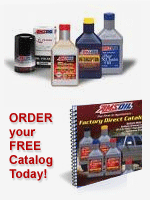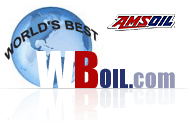Replacing popular conventional engine and driveline lubricants with AMSOIL synthetic lubricants in Class 8 diesel-fueled vehicles increases fuel mileage up to 8.2% according to the findings of an independent test facility.
Fuel accounts for roughly 37 percent of Class 8 truck operating expenses, and reducing fuel expenses is a top priority for truck operators.
AMSOIL is the leader in the race to develop fuel efficient low-viscosity lubricants for trucking and other heavy-duty diesel applications. Independent laboratory testing shows AMSOIL Series 3000 Synthetic 5W-30 Heavy Duty Diesel Oil in the engine and AMSOIL synthetics in the drivetrain provide up to 8.2 percent more miles-per-gallon than other popular lubricants provide.
Introduction
At the request of AMSOIL INC., an independent research institute conducted a month-long test com-paring the fuel consumption of Class 8 diesel trucks equipped with AMSOIL synthetic lubricants to Class 8 diesel trucks equipped with conventional lubricants.
The research institute used the SAE J1321 Joint TMC/SAE Fuel Consumption Test Procedure-Type II, an industry standard test procedure for comparing in-service fuel consumption of a vehicle operated under two conditions, one with the control lubricants in place, the other with the test lubricants in place.
Vehicles and Route
The three test and one control vehicles were 1995 International Model 9200 truck-tractors with Cummins M-11 engines (rated at 350 hp at 1600 rpm), Fuller RTXF 14710B transmissions, Eaton Model DS/RS 404 drive axles (3.90 ratio), 11R-24.5 low-profile tires and new oil and air filters. All four vehicles had been operated between 250,000 and 285,000 miles prior to the study.
The trucks were equipped with auxiliary weigh fuel tanks and quick disconnect couplings to facilitate accurate data gathering. Each truck pulled a 45-foot long flatbed trailer equipped with 11R-24.5 low-profile tires and loaded with concrete blocks so that the gross vehicle weight (GVW) of each vehicle was 75,550 +/-100 lbs.
The test route represented typical long-haul interstate highway operations, with asphalt road surfaces and generally flat terrain. The low traffic density route covered a total of 40 miles with a 20-mile southbound segment and the return north-bound segment. Fuel consumption was measured separately for each direction.
Lubricants and Fuels
The control lubricants were Shell Rotella T 15W-40 for the engines, Quaker State SAE 90 for the transmissions and Citco 85W-140 for the drive axles. The control truck used the control lubricants for all driving segments and the test trucks used the control lubricants for their baseline segments.
The test lubricants were AMSOIL Series 3000 Synthetic 5W-30 Heavy Duty Diesel Oil for the engines, AMSOIL Series 2000 Synthetic 20W-50 Racing Oil for the transmissions and AMSOIL Series 2000 Synthetic 75W-90 Gear Lube (Replaced by AMSOIL Long Life Synthetic Gear Lube SAE 75W-90) for the drive axles. The test vehicles used the test lubricants for their test segments.
All vehicles used Exxon No. 2 diesel fuel dispensed from the same storage tank for all driving segments.
Procedure
Each test vehicle ran a baseline segment, in which the truck was equipped with the control lubricants, and three test segments, in which it was equipped with test lubricants. The control vehicle concurrently ran each driving segment using control lubricants.
Conditions including speed, tire pressure, headlight and fan use and window openings were held constant between all vehicles in each driving segment. Finally, testing proceeded only if wind direction, wind speed and temperature were within test parameters.
Results
The weight of fuel consumed by each test vehicle and the weight of fuel consumed by the control vehicle in each driving segment were used to determine the percentage of fuel saved and the percentage fuel efficiency improvement obtained by the test lubricants. Results outside 2 percent of the norm were discarded.
Findings
The vehicles equipped with AMSOIL synthetic lubricants in the engines, transmissions and drive axles demonstrated up to an 8.2 percent increase in miles per gallon (mpg) over the mpg obtained by the vehicles equipped with the control lubricants.
Discussion
Test conditions were held close to ideal for maximum fuel economy. In many instances of less-than-ideal conditions, the synthetic test lubricants would have provided even more fuel economy improvement. For example, synthetics superior cold temperature fluidity provides a larger proportion of fuel savings in cold operating conditions.
Additionally, while the present study did not include analysis of wear control, wear control is an important issue with low viscosity lubricants and one fully addressed by AMSOIL through additional testing.
Traditionally, the benefit of improved fuel economy provided by low viscosity lubricants is offset by a penalty in wear control. Such is not the case with Series 3000 motor oil, as evidenced by Four-Ball Wear testing conducted by an independent laboratory and a growing body of demonstration and on-road data.
For example, an ongoing fleet demonstration is providing evidence of the excellent wear control of Series 3000. Since January 1996, AMSOIL and a northern tier trucking fleet have been conducting a demonstration using Series 3000 in the 1996 Cummins N-14 ESP3 engines of five 1996 Kenworth class 8 trucks.
The trucks traveled 125,000 miles with-out an oil change and the rate of wear metal generation found in used Series 3000 samples was lower than that found in used control oil, Pennzoil Long Life 15W-40, which is changed at 20,000-mile intervals.
Additionally, the viscometrics of the AMSOIL fluids provide a wear control benefit in cold temperature applications since low viscosity fluids flow more freely in cold temperatures than high viscosity fluids do. Oils that flow easily in cold temperatures provide faster post-startup wear protection in cold engines than do less fluid oils. They also provide easier starting and reduced battery drain.
Finally, AMSOIL product users are protected by the AMSOIL warranty, which, unlike warranties offered by other oil companies, is not limited by time or mileage and does not require user registration and approval.
Conclusion
Four Ball Wear Test (ASTM D-4172B) AMSOIL synthetic engine, transmission and drive axle lubricants provide a safe and effective means to significantly increase class 8 truck fuel economy.
AMSOIL Series 3000 Synthetic 5W-30 Heavy Duty Diesel Motor Oil provides better wear protection than these popular high viscosity diesel oils.
What Does a Savings of 8.2% Mean?
Imagine a fleet of 100 class 8 vehicles running an average 120,000 miles per year at an average 6.5 mpg with diesel fuel at $1.35 a gallon. The fleet spends $2,492,308 on fuel annually. Now imagine the fleet uses AMSOIL products and improves its miles-per-gallon by 8.2 percent. The fleet now spends $2,303,427 on fuel annually.
Thats a savings of $188,881! That money could buy a years worth of AMSOIL synthetic lubricants for the fleet plus a years fuel for 3 to 6 trucks with cash left over!
CUMMINS M-11 ENGINE
Sump capacity: 9 gallons
Thats a savings
of $188,881! That money could buy a years worth of AMSOIL
synthetic lubricants for the fleet plus a years fuel for 3 to 6 trucks
with cash left over!
CUMMINS M-11 ENGINE
Sump capacity: 9 gallons
|
















 Canada
Canada United States
United States